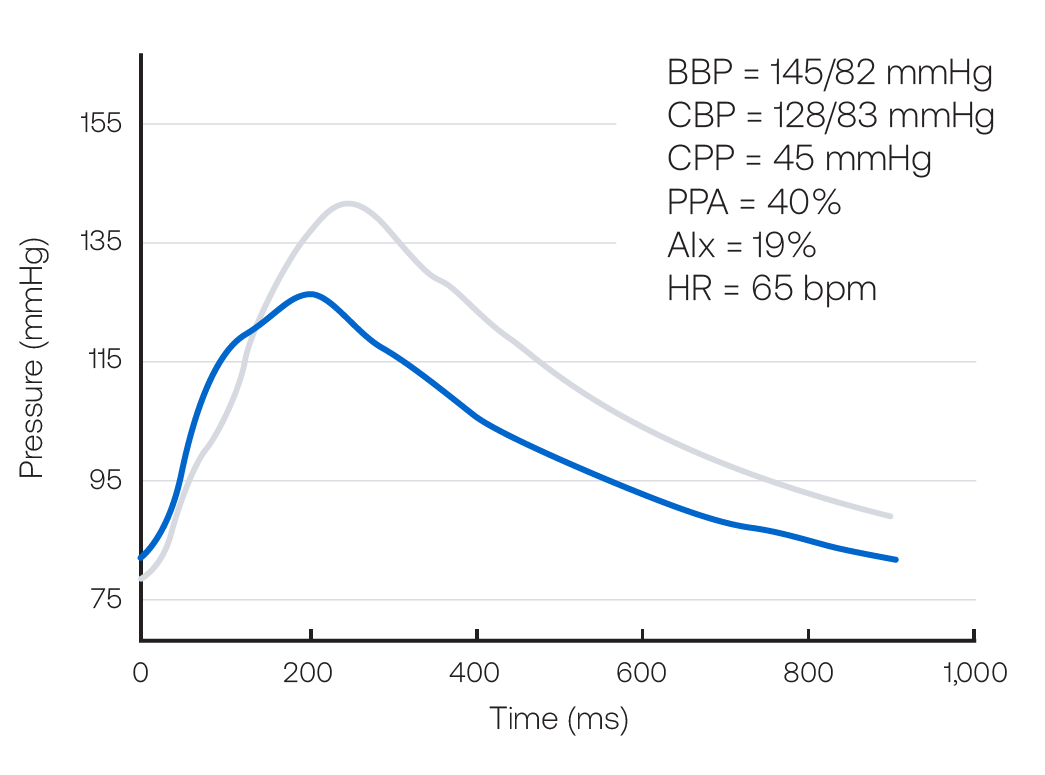
41-Year-Old Male with Untreated Hypertension
February 14, 2024
45-Year-Old Male with Uncontrolled Hypertension
February 14, 2024Personalized Treatment Regimen Following Pulse Wave Analysis
64-Year-Old Male with Hypertension and Comorbidity
Patient Medical History
- Smoker
- History of heart attack and placement of two coronary stents
- Current Rx regimen
- Metoprolol XL 200 mg daily
- Hydralazine 100 mg twice daily
- Lisinopril 20 mg daily
- Furosemide 20 mg daily
- Atorvastatin 40 mg daily
Initial Digital Vascular Biomarker Assessment
| Brachial Blood Pressure | 158/78 mmHg |
| Central Systolic Pressure | 142 mmHg |
| Central Pulse Pressure Amplification | 16% |
| Augmentation Index | 21% |
Initial Assessment Interpretation
This male patient’s central pressure profile indicates a pulse pressure amplification of 16% (less than the desired value of 30%). The central systolic pressure of 142 mmHg is more than 124 mmHg. The Augmentation Index (AIx) is 21%.
Figure 15. Central Pressure Waveform

BBP indicates brachial blood pressure systolic/diastolic; CBP, central blood pressure systolic/diastolic; CPP, central pulse pressure; AIx, augmentation index; HR, heart rate; bpm, beats per minute.
Intervention
A number of changes in medications were made along with the advice to stop smoking. The goal of the medication changes is to reduce brachial systolic to < 140 mmHg, increase pulse pressure amplification, and reduce central systolic pressure to < 124 mmHg. ß-Blockers tend to blunt amplification, therefore, the dose of the ß-blocker is gradually reduced. Furosemide was changed to indapamide, a longer reacting diuretic. A calcium channel blocker (CCB) is initiated and the ACE inhibitor is changed, increasing the dose over time and then merging with the CCB in a fixed-dose combination. In addition, counseling on cigarette smoking is provided. These changes are gradual over 8 months.
2Follow Up Digital Vascular Biomarker Assessment
| Brachial Blood Pressure | 142/82 mmHg |
| Central Systolic Pressure | 128 mmHg |
| Central Pulse Pressure Amplification | 40% |
| Augmentation Index | 19% |
Follow up Assessment Interpretation
After eight months, this male patient had a follow-up. The patient was on the following medications:: Metoprolol XL 25mg daily, amlodipine / benazepril 10mg/40mg daily, spironolactone 25mg daily, and indapamide 1.25mg daily. The patient had also ceased cigarette smoking.
The central pressure profile indicates that pulse pressure amplification has increased from 16% to 40%. The central systolic pressure of 128 mmHg is closer to the desired value of 124 mmHg. The AIx was lowered slightly from 21% to 19%. In the 8-month interval, the heart rate is now 65 beats per minute (increased from 48 beats per minute).
The initial brachial pressures were in need of attention. Changes were made in the antihypertensive regimen with a goal of maintaining some ß-blockade but to increase the vasodilatory aspect of the regimen, relying especially on the central pressure–lowering effects of ACE inhibitors and dihydropyridine CCBs.
*Townsend RR et al. Journal of Clinical Hypertension. 2015; 17:7, 503–513.
http://bit.ly/2gc5mdD
Figure 9. Central Pressure Waveform

Other Case Studies
